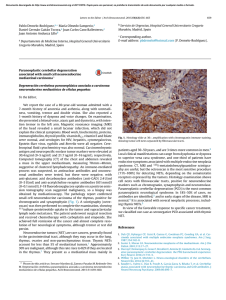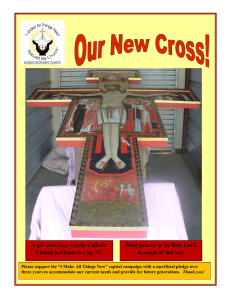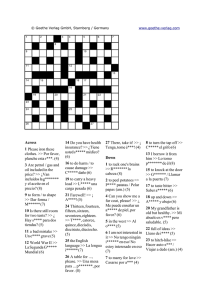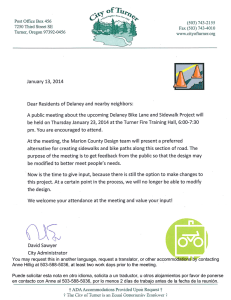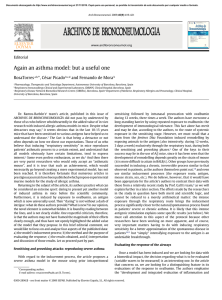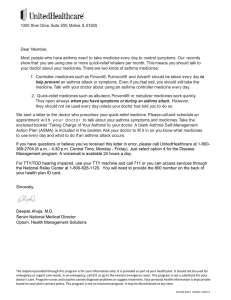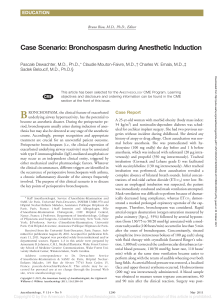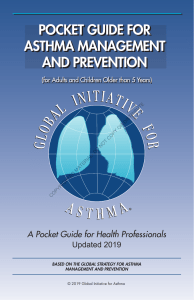Knowledge of pediatricians in Rio de Janeiro, Brazil, about
Anuncio
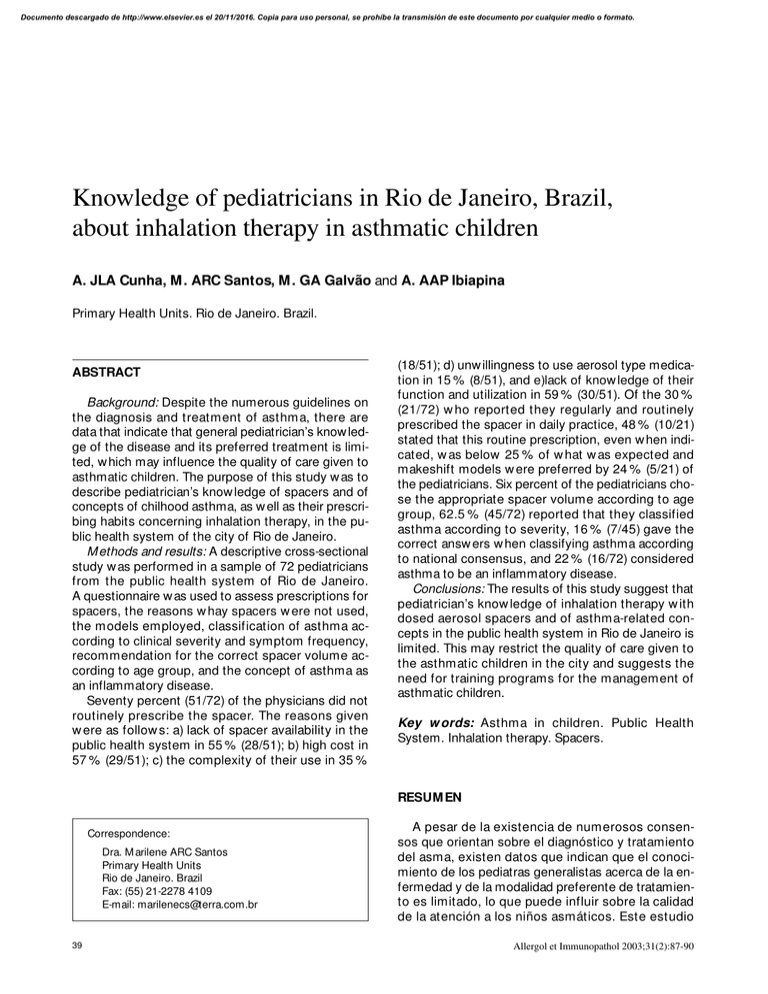
Documento descargado de http://www.elsevier.es el 20/11/2016. Copia para uso personal, se prohíbe la transmisión de este documento por cualquier medio o formato. O RI G I N AL ARTI CLES Knowledge of pediatricians in Rio de Janeiro, Brazil, about inhalation therapy in asthmatic children A. JLA Cunha, M . ARC Santos, M . GA Galvão and A. AAP Ibiapina Primary Health Units. Rio de Janeiro. Brazil. ABSTRACT Background: Despite the numerous guidelines on the diagnosis and treatment of asthma, there are data that indicate that general pediatrician’s know ledge of the disease and its preferred treatment is limited, w hich may influence the quality of care given to asthmatic children. The purpose of this study w as to describe pediatrician’s know ledge of spacers and of concepts of chilhood asthma, as w ell as their prescribing habits concerning inhalation therapy, in the public health system of the city of Rio de Janeiro. M ethods and results: A descriptive cross-sectional study w as performed in a sample of 72 pediatricians from the public health system of Rio de Janeiro. A questionnaire w as used to assess prescriptions for spacers, the reasons w hay spacers w ere not used, the models employed, classification of asthma according to clinical severity and symptom frequency, recommendation for the correct spacer volume according to age group, and the concept of asthma as an inflammatory disease. Seventy percent (51/72) of the physicians did not routinely prescribe the spacer. The reasons given w ere as follow s: a) lack of spacer availability in the public health system in 55 % (28/51); b) high cost in 57 % (29/51); c) the complexity of their use in 35 % (18/51); d) unw illingness to use aerosol type medication in 15 % (8/51), and e)lack of know ledge of their function and utilization in 59 % (30/51). Of the 30 % (21/72) w ho reported they regularly and routinely prescribed the spacer in daily practice, 48 % (10/21) stated that this routine prescription, even w hen indicated, w as below 25 % of w hat w as expected and makeshift models w ere preferred by 24 % (5/21) of the pediatricians. Six percent of the pediatricians chose the appropriate spacer volume according to age group, 62.5 % (45/72) reported that they classified asthma according to severity, 16 % (7/45) gave the correct answ ers w hen classifying asthma according to national consensus, and 22 % (16/72) considered asthma to be an inflammatory disease. Conclusions: The results of this study suggest that pediatrician’s know ledge of inhalation therapy w ith dosed aerosol spacers and of asthma-related concepts in the public health system in Rio de Janeiro is limited. This may restrict the quality of care given to the asthmatic children in the city and suggests the need for training programs for the management of asthmatic children. Key w ords: Asthma in children. Public Health System. Inhalation therapy. Spacers. RESUM EN Correspondence: Dra. M arilene ARC Santos Primary Health Units Rio de Janeiro. Brazil Fax: (55) 21-2278 4109 E-mail: [email protected] 39 A pesar de la existencia de numerosos consensos que orientan sobre el diagnóstico y tratamiento del asma, existen datos que indican que el conocimiento de los pediatras generalistas acerca de la enfermedad y de la modalidad preferente de tratamiento es limitado, lo que puede influir sobre la calidad de la atención a los niños asmáticos. Este estudio Allergol et Immunopathol 2003;31(2):87-90 Documento descargado de http://www.elsevier.es el 20/11/2016. Copia para uso personal, se prohíbe la transmisión de este documento por cualquier medio o formato. 88 JLA Cunha A, et al.— KNOWLEDGE OF PEDIATRICIANS IN RIO DE JANEIRO, BRAZIL, ABOUT INHALATION THERAPY IN ASTHMATIC CHILDREN tuvo como objetivo valorar los conocimientos y prácticas de los médicos pediatras de la Red Básica de Salud del municipio de Río de Janeiro con respecto al empleo de cámaras espaciadoras y también en cuanto al concepto del asma en la infancia. M étodos y resultados: Se ha realizado un estudio transversal descriptivo con una muestra de 72 pediatras de la Red Básica de Salud de Río de Janeiro, evaluados por medio de un cuestionario, con relación a la prescripción del espaciador, a los motivos para abstenerse de utilizar los espaciadores, a los modelos empleados, a la clasificación del asma por gravedad clínica y por frecuencia de síntomas, a la recomendación del volumen correcto del espaciador por edad y al concepto de asma como enfermedad inflamatoria. Se ha observado que 70 % (51/72) de los médicos no prescriben el espaciador como rutina. Los motivos alegados para no hacer esta prescripción fueron: 55 % (28/51) por no estar disponibles en la Red, 57 % (29/51) por ser de costo elevado, 35 % (18/51) por la complejidad en su utilización, 15 % (8/51) por no utilizar fármacos en forma de aerosol y, 59 % (30/51) por el desconocimiento de su función y utilización. De los 30 % (21/72) que han alegado haber efectuado la prescripción regular del espaciador en la práctica diaria, 48 % (10/21) han afirmado que incluso cuando indicado, la prescripción rutinaria era menor que 25 % de lo esperado, siendo que los modelos artesanales fueron indicados en 24 % de los casos. Seis por ciento de los pediatras han elegido el volumen adecuado del espaciador por edad, 62,5 % (45/72) han afirmado clasificar el asma por gravedad, 16 % (7/45) acertaran en las cuestiones con respecto a la clasificación del asma por el consenso nacional y 22 % (16/72) han entendido el asma como enfermedad inflamatoria. Conclusiones: Los resultados han sugerido que en nuestro medio resulta limitado el conocimiento de los médicos con respecto a la terapia por inhalación con aerosol dosimetrado y espaciadores y con respecto a algunos conceptos relativos al asma. Este hecho puede limitar la calidad de la atención prestada al niño asmático en Río de Janeiro e indica la necesidad de programas de capacitación para atención a niños asmáticos. Palabras clave: Asma infantil. Atención primaria. Terapéutica inhalatoria. Cámaras espaciadoras. INTRODUCTION There is increasing prevalence, severity and mortality of asthma w orldw ide1-4, even though this diseaAllergol et Immunopathol 2003;31(2):87-90 se has been the subject of top national and international congresses recommending the “ best practices” relating to diagnosis and treatment 5. One of the reasons contributing to the rise in mortality is inadequate treatment 6. Reports indicate that inhalation is the most common treatment in a crisis and during the intercritical period7-9. Nevertheless, data from different countries show a gap betw een general recommendations and daily practice 7,10,11. The poor know ledge of physicians about asthma and about the correct use of the spacer and dosed aerosol, w hich are essential in treating asthma, especially in the pediatric age group, has been indicated as a decisive factor in the inadequate instructions to patients and their families and in the consequent unsuitable technique adopted for children6,12. Rio de Janeiro data show s that asthma is a w idespread disease in this area. In 1998, around 235,175 children under 5 years old w ere attended in outpatients units. Wheezing diseases accounted for 17 % (39,980) of all consultations registered. Today, patients seeking municipal pediatric clinics in Rio de Janeiro do not have access to spacers and dosed aerosols. Nor is there any information available about the know ledge of physicians concerning asthma and the prescription of spacers in inhalation therapy for children attended in these primary health care units. The purpose of this study w as to discuss the know ledge and practice of pediatricians w ith regard to prescribing spacers as an aid to inhalation therapy for asthmatic children and to learn about concepts referring to bronchial asthma in childhood. The results may be used in preparing future asthma-control actions in the State. M ATERIAL AND M ETHODS A cross-sectional study w as undertaken to describe the know ledge and practices of physicians in the Rio de Janeiro public health system attending patients under 14 years old. The sample consisted of pediatricians w ho spontaneously participated in one of the tw o of refresher courses on asthma in childhood organized by the local health secretary in August and October 2000. The variables under study w ere age, gender, time since graduation, spacer prescription, alleged reasons for not routinely using the spacer, spacer models normally employed in medical practice and the classification of asthma according to its clinical severity. The 2 nd Brazilian Consensus on Asthma Treatment 9 w as adopted as a benchmark. Professional know ledge on the follow ing items w as 40 Documento descargado de http://www.elsevier.es el 20/11/2016. Copia para uso personal, se prohíbe la transmisión de este documento por cualquier medio o formato. JLA Cunha A, et al.— KNOWLEDGE OF PEDIATRICIANS IN RIO DE JANEIRO, BRAZIL, ABOUT INHALATION THERAPY IN ASTHMATIC CHILDREN 89 Table I also evaluated: classification of asthma according to the frequency of respiratory symptoms presented by the patient, correct volume of the spacer according to age group, and the concept of asthma as an inflammatory disease using as reference the decisions made at the 2 nd Brazilian Consensus on Asthma Treatment 9. A self-applicable questionnaire w ith a total of 25 open and closed questions responded by pediatricians, before they started the course classes. The data w as processed using the EpiInfo 6.02 application and the average, standard deviation (SD) and frequency distribution of the variables w ere calculated. This study w as approved by the local Rio de Janeiro Ethics and Research Commission. 22 % (16/72) demonstrated the know ledge that asthma is an inflammatory disease. RESULTS DISCUSSION Seventy-tw o of eighty physicians present agreed to answ er the questionnaire, 85.2 % of w hom w ere female. The average age of the professionals w as 44 years old (67) and the average time since graduation and professional practice w as 20 years. It w as found that 70 % did not prescribe the spacer on a routine basis. The reasons alleged for not prescribing its use w ere: 55 % (28/51) since they are not available in the local health system, 57 % (29/51) due to its high cost, 35 % (18/51) due to its complex utilization, 15 % (8/51) due to the non utilization of aerosol medicines, and, 59 % (30/51) due to the lack of know ledge on its function and utilization (table I). Forty-eight percent (10/21) of the 30 % (21/72) that claimed to regularly prescribe the spacer in daily practice affirmed that even w hen it w as convenient the routine prescription w as less than 25 % of the expected. The makeshift models w ere preferred by 24 % (5/21) of the pediatricians, the manufactured by 19 % (4/21) and 57 % (12/21) of them could not recommend any model although they claimed to use this device. When asked about the most appropriate volume for patients under and over three years old, it w as found that only 6 % (4/72) w ere able to suitably choose the volumetric content of the spacer chamber according to the patient’s age group. Concerning the practice of classifying the severity of the asthma during a consultation, 62.5 % (45/72) stated that this w as routine practice. Nevertheless, w hen asked about asthma classification according to the frequency of respiratory symptoms adopting the benchmark of the 2nd Brazilian Consensus on Asthma9, it w as found that only 16 % (7/45) answ ered correctly. The remaining 84 % (38/45) either did not know how to classify or respond, or answ ered incorrectly. Only The results of this study show ed that pediatricians did not prescribe the use of the spacer in inhalation therapy on a routine basis, and the ignorance about its use and function is the main reason for this behavior. The Brazilian consensus on treating asthma that recommends inhalation as the preferable treatment and w hich has been available in Brazil since 199413 and the results of this study suggest that few physicians adopt this practice. Despite the various existing recommendations for the utilization of inhalation in the treatment of asthma1,9, little progress has been made on this subject, oral administration still being preferred in the treatment of asthma. M oreover, the majority of the pediatricians did not consider asthma to be an inflammatory disease and could not classify this disease by severity, suggesting that the general reports on their ow n are not able to update concepts and modify the conduct of medical professionals, even the most experienced w ith 20 years of pediatric practice. Since asthma is essentially a disease attended in outpatient units14 it is possible that this gap existing betw een the national consensus and the know ledge and practices of pediatricians in the Rio de Janeiro local public health system may be detrimental to the quality of care given to the asthmatic child. Despite the differences in methodology, the results of the study herein coincide w ith the literature15,6, w hich show that a significant proportion of professionals w ho participate directly in the treatment of asthma has a limited know ledge about the disease-related concepts and the use of spacers and dosed aerosols. Although this w ork does not intend to study the reasons for these constraints, it is know n that in Brazil and in other countries14,6, the for- 41 Justification for failure by Rio de Janeiro pediatricians to prescribe spacers (2000) Reasons given Lack of knowledge Non-prescription of inhalation Complex use High cost Unavailable in the public health system Number Percentage 30 08 18 29 28 59 15 35 57 55 Allergol et Immunopathol 2003;31(2):87-90 Documento descargado de http://www.elsevier.es el 20/11/2016. Copia para uso personal, se prohíbe la transmisión de este documento por cualquier medio o formato. 90 JLA Cunha A, et al.— KNOWLEDGE OF PEDIATRICIANS IN RIO DE JANEIRO, BRAZIL, ABOUT INHALATION THERAPY IN ASTHMATIC CHILDREN mal medical training to use the resources designed for inhalation therapy is not included in the syllabus of most graduate and post-graduate medical schools, w hich may have contributed to the results achieved. The belief is that this sample, albeit appropriate, may point to the tendency among Rio de Janeiro pediatricians. It is possible that the physicians w ho have spontaneously attended the aforementioned course have been those less interested in the topic being updated, and that the real situation w ould be better than that encountered. How ever, it is hard to conceive that the use of spacers fixed to pressurized dosed nebulizers is greater than verified (30 % ), since there are no aerosol medicines and spacers available for patients in the Rio de Janeiro local health system. On the other hand, if the sample had mostly involved physicians interested in asthma, and therefore more apt, the actual situation could be w orse than that under study. The fact that a self-completing questionnaire w as used, in w hich the name of the professional w as not disclosed and all information w as confidential, reinforces the impression that the answ ers w ere genuine. Evidence of the restricted know ledge of the pediatricians on the inhalation therapy in bronchial asthma, possibly influencing daily medical practice, suggests the need for a training program for Rio de Janeiro pediatricians. The idea of this initiative w ould be to improve the understanding of the disease, familiarize physicians w ith the most appropriate means available for the treatment of asthma and encourage the adoption of national recommendations on treating asthma. Another important and complementary action w ould be to introduce formal training in medical faculties. Allergol et Immunopathol 2003;31(2):87-90 REFERENCES 1. Szilagyi PG, Kemper KJ. M anagement of chronic childhood asthma in the primary care office. Pediatric Annals 1999; 28:43-52. 2. Solé D, Naspitz CK. Epidemiologia da asma: estudo ISAAC (International Study of Asthma and Allergies in Childhood). Rev Bras Alergia Immunopatol 1998;21:38-45. 3. Kun HY, Oates RK, M ellis CM . Hospital admissions and attendances for asthma – a true increase? M ed J Aust 1993;159: 312-3. 4. Juel K, Pedersen PA. Increasing asthma mortality in Denmark 1969-88 not a result of a changed coding practice. Ann Allergy 1992;68:180-2. 5. Crim C. Clinical practice guidelines actual vs actual clinical practice. The asthma paradigm. Chest 2000;118:62S-64S. 6. Interiano B, Guntupalli KK. M etered-dose inhalers: do health care providers know w hat to teach? Arch Intern M ed 1993; 153:81-5. 7. Gazarian M , Henry RL, Wales SR, M icallef BE, Rood EM , O’M eara M W, et al. Evaluating the effectiveness of evidence-based guidelines for the use of spacer devices in children w ith acute asthma. M ed J Aust 2001;74: 394-7. 8. Pow ell CVE. M ultidisciplinary effort can help update approach to acute asthm a treatm ent. Arch Dis Child 2001;84: 142-6. 9. Sociedade Brasileira de Pneumologia e Tisiologia, Sociedade Brasileira de Alergia e Imunopatologia, Sociedade Brasileira de Pediatria. III Consenso Brasileiro no M anejo da Asma. J Pneumol 2002;28 (Supl 1):S1-S28. 10. Finkelstein JA, Lozano P, Shulruff R, Inui TS, Soumerai SB, Ng M , et al. Self-reported physician practices for children w ith asthma: are national guidelines follow ed? Pediatrics 2000; 106:886-96. 11. Ockene JK, Zapka JG. Provider education to promote implementation of clinical practice guidelines. Chest 2000;118: 33S-9S. 12. Scott-Smith W. Scoring inhaler technique in general practice. The Practitioner 1986;230:96. 13. Sociedade Brasileira de Alergia e Imunopatologia, Sociedade Brasileira de Pediatria, Sociedade Brasileira de Pneumologia e Tisiologia. 1.º Consenso Brasileiro no M anejo da Asma. Fortaleza-Ceará. Boehringer De Angeli. 1994; p. 42. 14. Evans D, M ellins R, Lobach K, Ramos-Bonoan C, Pinkett-Heller M , Wiesemann S, et al. Improving care for minority w ith asthma: professional education in public health clinics. Pediatrics 1997;99:157-64. 15. Jones JS, Holstege CP, Riekse R, White L, Bergquist T. M etered-dose inhalers: do emergency health care providers know w hat to teach? Ann Emerg M ed 1995;26:308-11. 42
